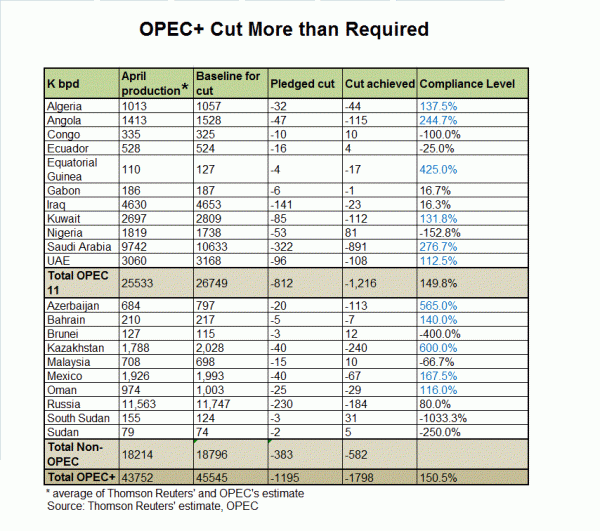OPEC+ stayed put, maintaining the output cut agreed in December last year while pledging to monitor market developments with an option to raise production later. In our opinion, there is no practical need for OPEC+ to officially raise output. Despite US sanctions against Venezuela and Iran, as well as geopolitical tensions in the Middle East, world supply is still sufficient to meet the demand. Undoubtedly, some producers find raising output desirable to boost their national revenues, while others attempt to talk down oil prices (by hinting a possibility of raising output) in accommodation to Donald Trump, who always pressures his Middle East allies to lower oil price. There is a real risk that disruption in production in some countries, such as Iran, Venezuela and Libya, could lead to global oil deficit. Yet, production data have suggested that OPEC+ has, in aggregate, reduced output significantly more than required. Producers that have lowered output more than required can increase production to offset the loss in Iran and Venezuelan production when necessary. There is no need to officially break the output cut deal.
Oil Demand/Supply Balance
As suggested in the latest reports by three major oil agencies, both US Energy Information Agency (EIA) and the Paris-based International Energy Agency (IEA) have revised slightly lower their forecasts for global oil demand for 2019. Meanwhile, both have upgraded non-OPEC oil supply for the year. The balance signals reduced need for OPEC’s production. According to the EIA, world oil demand would reach 101.36M bpd this year, down -0.02M bpd or -0.02%, from April’s forecast. While about 70% of it would be met by non-OPEC production and natural gas liquids (NGLs) and unconventional liquids, the rest would depend on OPEC’s output. EIA forecasts the demand for OPEC’s output would be 30.54M bpd. Ongoing political uncertainty in the Middle East region and US sanctions against Iran and Venezuela have raised uncertainty about OPEC’s output. The EIA anticipates that the loss of Iranian output would be compensated by increases in Saudi Arabia, the United Arab Emirates, Kuwait, and Russia. Yet, the decline in Venezuelan production would hardly be substituted. This is also a caused of EIA’s upward adjustment in its oil price forecast. As noted in the report, “unrest within Venezuela contributes to a highly uncertain situation that could immediately disrupt the remaining oil production there”. It is expected that “Venezuela’s production will continue to see significant declines through 2020”. Moreover, “although recent fighting in Libya had not affected any crude oil production or export infrastructure as of the time of writing, the civil unrest has increased the disruption risk significantly”. EIA forecast the call for OPEC production would be 30.54M bpd.
The IEA revised lower slightly its forecast for global demand for this year. It forecast demand would reach 100.4M bpd in 2019, up from 99.1M bpd a year ago but down from April’s projection of 100.6M bpd. On the supply side, the agency indicated that Trump’s decision to end sanctions waivers in Iran has added to the “confusing supply outlook”. Yet, it also has noted a “very welcome signals from other producers that they will step in to replace Iran’s barrels, albeit gradually in response to requests from customers”. While the majority of global oil demand would be met by non-OPEC supply, IEA forecasts the balance would be matched by OPEC supply of 30.9M bpd 2Q19. The amount would then drop to 30.2M bpd in 2H19.
OPEC’s report revealed that the cartel estimated global oil demand to reach 99.94M bpd in 2019. While it remains the lowest among the three agencies, it has already modestly revised from April’s forecast of 99.91M bpd. On the supply side, OPEC forecast the world needs 30.64M bpd of its output. The cartel reported that its 15 members produced 30.03M bpd in April, down from 30.46M bpd in 1Q19 and 31.86M bpd in the full year of 2018.
OPEC+ Compliance
On aggregate, OPEC+ has been producing much less than their quotas. In April, compliance rate for OPEC-11 reached 150%*. That is, the members almost doubled the output cut they are required. 6 out of the 11 members cut more than required, while the rest either cut less or actually raised production. For instance, Saudi Arabia, the world’s largest oil exporter, lowered its output by 891K bpd, while it was required to cut only by -322K bpd. UAE also lowered its output by 108K bpd, although it agreed to cut by 96K bpd. Concerning non-OPEC participants of the deal, oil giant Russia’s compliance level is persistently below 100%, i.e. cutting less than agreed. Indeed, the country is always vocal of raising output and threatening about quitting the deal. Yet, there are 5 out of 10 non-OPEC participants that cut more than required.
it appears that OPEC production has been short of the world’s demand for its supply. Yet, it was driven by some producers’ deliberate reduction of output. These producers can increase production to offset the loss in Iran and Venezuelan production when necessary. There is no need to officially break the output cut deal.














